Spatial Sampling
You are here
Spatial Sampling for Mapping
To be announced
Scope
Sound sampling design is essential for the collection of data to support reliable scientific inference and decision making for management and policy. What counts as a sound design depends on the problem of interest, and the nature of the statistical inference that is required. Two broad aims can be distinguished, estimating the overall mean or total of a population, e.g. the total soil carbon stock in an area, and mapping. Estimating the means or totals of several subpopulations (subareas) is in between these two extremes. This course presents an overview of spatial sampling strategies for the full spectrum of aims. For estimating (sub)population means or totals probability sampling and design-based or model-assisted estimation is most appropriate, whereas for mapping probability sampling is not required, and there is scope to optimize the locations of the sampling points with a statistical model of the spatial variation.
In this course you will learn how to choose a sampling design that is most appropriate for the aim of your project. Theoretical concepts from classical sampling and geostatistics will be explained with a strong emphasis on practical application. In the course you will be provided with scripts for the free R platform, which will allow you to use the methods that are described to solve your sampling problems.
Programme
Day 1 (afternoon): Overview of spatial sampling strategies; Probability sampling for estimating population means
- Probability sampling versus non-probability sampling. Design-based versus model-based statistical inference; Horvitz-Thompson estimator
- Simple random sampling
Day 2: More advanced probability sampling designs and model-assisted estimation of population means
- Stratified simple random sampling
- Overview of other probability sampling designs (systematic random sampling, cluster random sampling, two-stage cluster random sampling, balanced sampling, ....)
- Regression and ratio estimators of population means
Day 3 Sampling for mapping
- Regular grid sampling for mapping
- Spatial coverage sampling for mapping
- Covariate space coverage sampling and conditioned Latin hypercube sampling for mapping
- Introduction to kriging
- Model-based optimization of grid spacing for ordinary kriging and kriging with an external drift
Day 4 Model-based sampling for mapping; Sampling for map validation
- Model-based optimization of sampling pattern for ordinary kriging and kriging with an external drift
- Sampling for validation of maps
General information
| Target Group | The course is aimed at PhD candidates and other academics |
| Group Size | Min. 16, max. 20 participants |
| Course duration | 3 days (2 half day, 2 full days) |
| Language of instruction | English |
| Frequency of recurrence | Once every two years |
| Number of credits | 0.9 ECTS |
| Lecturers | Dr. Dick Brus (Alterra - Soil, water and land use, Wageningen UR) |
| Prior knowledge | Basic knowledge of R is assumed |
| Location | To be determined |
| Options for accommodation | Accommodation is not included in the fee of the course, but there are several possibilities in Wageningen. For information on B&B's and hotels in Wageningen please visit proefwageningen.nl. Another option is Short Stay Wageningen. Furthermore Airbnb offers several rooms in the area. Finally, there is also a very active public Facebook group called “Wageningen Student Plaza”, where rooms are often offered for short-term sublets, but where one could also easily post a request for renting a room for a week in Wageningen. Finally, note that besides the restaurants in Wageningen, there are also options to have dinner at Wageningen Campus. |
More information
Dr. Sabine Vreeburg (PE&RC)
Phone: +31 (0) 317 485853
Email: sabine.vreeburg@wur.nl
Registration of interest
At this moment, this course is not scheduled yet. However, if you register your interest in this activity below, we will inform you as soon as the course is scheduled and registration of participation is opened.

